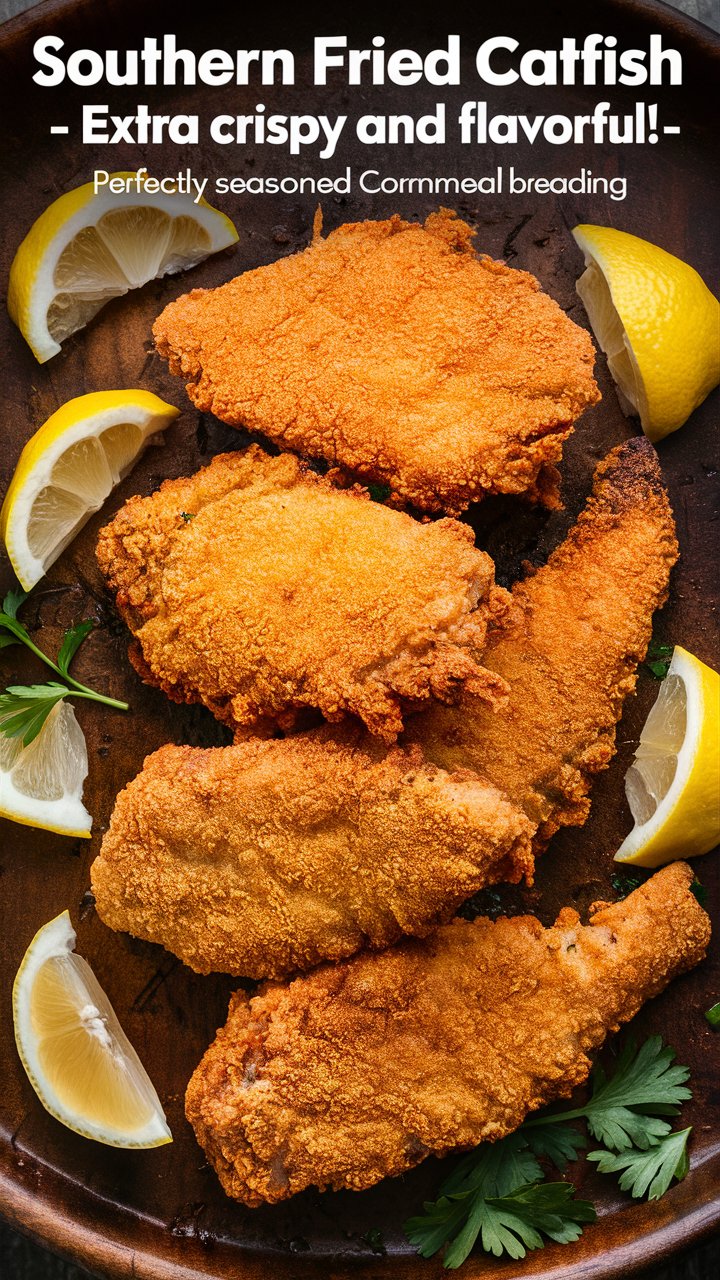Southern Fried Catfish is more than just a meal—it’s a cultural experience, a tribute to heritage, and a comfort food that has stood the test of time. With its crispy, golden crust and tender, flaky interior, it represents the heart and soul of Southern cuisine. From weekend fish fries to family reunions, this dish evokes memories of laughter, tradition, and delicious simplicity.
In this comprehensive guide, we’ll explore everything you need to know about Southern Fried Catfish—from its historical roots and nutritional value to step-by-step cooking techniques and modern twists. Whether you’re a seasoned home cook or a curious beginner, this article will walk you through how to perfect this timeless favorite in your own kitchen.
1. The History and Cultural Roots of Southern Fried Catfish
Southern Fried Catfish isn’t just food—it’s folklore. The tradition of frying fish dates back to early African American communities in the Southern U.S., particularly in the Mississippi Delta. Back when ingredients were limited and survival depended on ingenuity, catfish—readily available in rivers and lakes—became a staple.
In the 20th century, “Friday Fish Fry” became a common social event, especially in Southern towns. Churches, families, and entire neighborhoods would gather for these casual, joyous meals. To this day, fried catfish remains a symbol of unity, celebration, and regional pride.
2. Why Catfish? Understanding Its Popularity in the South
Catfish thrives in the warm waters of the American South and is relatively inexpensive and easy to farm. Its mild flavor, firm texture, and versatility make it ideal for frying.
- Flavor Profile: Slightly sweet and not overly “fishy”
- Texture: Dense yet flaky when cooked
- Cost-Effective: Farm-raised catfish is affordable and abundant
- Sustainability: Catfish farming is environmentally efficient compared to many other seafood practices
3. Choosing the Right Fish: Fresh vs. Frozen, Farm-Raised vs. Wild
Choosing the right catfish can significantly influence the outcome of your dish.
Fresh vs. Frozen
- Fresh: Offers superior texture and taste. Look for fillets that are firm, moist (not wet), and without an ammonia smell.
- Frozen: Convenient and longer-lasting. Thaw properly in the refrigerator overnight and pat dry thoroughly.
Farm-Raised vs. Wild
- Farm-Raised Catfish: Milder in taste, widely available, and more consistent in quality.
- Wild-Caught Catfish: Stronger flavor with a more robust texture. Some prefer its authenticity and character.
🟡 Tip: If you’re new to cooking fish, start with farm-raised for easier flavor control.
4. The Role of Buttermilk: Why It’s Essential
Buttermilk isn’t just for Southern biscuits—it’s the secret weapon in fried catfish. Soaking the fish in buttermilk:
- Tenderizes the flesh
- Neutralizes any muddy flavors
- Helps the coating stick
If you don’t have buttermilk on hand, mix ½ cup milk with 1 tablespoon of lemon juice or vinegar and let it sit for 5 minutes.
5. Cornmeal Crust Perfection: Getting That Classic Crunch
Cornmeal is the cornerstone of a true Southern catfish crust. It gives that gritty, golden crisp that flour alone cannot achieve.
Coating Mix Essentials:
- Fine yellow or white cornmeal
- All-purpose flour (for binding)
- Salt & pepper
- Optional: garlic powder, paprika, cayenne, or a seafood blend (like Old Bay)
The key is to keep the coating dry and evenly mixed. For extra crunch, double dredge the fish: coat → dip again in buttermilk → coat again.
6. Equipment You’ll Need to Fry Like a Pro
You don’t need fancy tools, but the right equipment ensures consistent results:
- Heavy Skillet or Dutch Oven: Retains heat better than lightweight pans
- Deep-Fry Thermometer: Crucial to maintain oil temp (ideal is 350–375°F)
- Wire Rack: Keeps your fish crispy while draining oil
- Tongs or Slotted Spoon: For safe flipping and removing from hot oil
- Paper Towels or Brown Paper Bags: To absorb excess oil
7. Step-by-Step Recipe for Southern Fried Catfish
Ingredients (Serves 2-3):
- 1 lb catfish fillets (cut into strips if large)
- ½ cup buttermilk
- ½ cup cold water
- 1½ cups fine cornmeal
- ½ cup all-purpose flour
- 1 tsp seafood seasoning (Old Bay or similar)
- Salt and pepper to taste
- 1 quart vegetable oil for frying
Instructions:
- Soak: In a shallow dish, mix buttermilk, water, salt, and pepper. Add the catfish and soak for 30 minutes.
- Mix Coating: Combine cornmeal, flour, seafood seasoning, and additional salt and pepper in another shallow dish.
- Heat Oil: Bring oil to 350°F in a heavy pan. Use a thermometer to avoid overheating.
- Dredge: Remove fish from buttermilk, let excess drip off, then coat thoroughly in the dry mixture.
- Fry: Fry each piece 3–4 minutes per side until golden brown.
- Drain: Transfer to a wire rack or paper towels.
- Serve Hot: With lemon wedges, tartar sauce, and traditional sides.
8. Pro Tips for Frying Fish Without the Mess
- Use a splatter screen to contain oil
- Line your counter with newspaper for quick cleanup
- Dispose of used oil safely—never pour down the drain
- Clean your pan while it’s warm, not hot
9. Creative Variations and Modern Twists
Want to give your fried catfish a makeover? Try these:
- Spicy Cajun Catfish: Add cayenne and smoked paprika to the coating
- Lemon-Pepper Crust: Zest a lemon into the cornmeal mix
- Gluten-Free Version: Use rice flour instead of all-purpose flour
- Herbed Crust: Mix in dried parsley, oregano, or dill
- Panko Finish: Blend panko crumbs into the coating for a lighter crunch
10. Perfect Side Dishes to Serve with Fried Catfish
A Southern table isn’t complete without soul-satisfying sides:
| Classic Sides | Creative Twists |
|---|---|
| Hush puppies | Jalapeño cornbread muffins |
| Coleslaw | Apple-fennel slaw |
| Collard greens | Sautéed kale with garlic |
| Potato salad | Sweet potato fries |
| Cornbread | Cheddar-chive biscuits |
Don’t forget the sweet tea and hot sauce on the side!
11. Healthy Alternatives and Air-Frying Methods
Looking for a lighter version of fried catfish?
Air Fryer Method:
- Preheat air fryer to 390°F
- Lightly spray fillets with oil
- Cook for 10–12 minutes, flipping once halfway
Oven-Baked Catfish:
- Place coated fish on a wire rack over a baking sheet
- Bake at 400°F for 15–18 minutes until crisp
🟢 Both methods reduce fat while preserving flavor.
12. Storage and Reheating Without Losing the Crunch
Storage Tips:
- Store in airtight containers in the fridge (up to 2 days)
- Freeze tightly wrapped for up to 1 month
Reheating Instructions:
- Oven: 350°F for 10–12 minutes
- Air fryer: 375°F for 6–8 minutes
- Avoid microwaving – it ruins the crispiness
13. Common Mistakes to Avoid
❌ Overcrowding the pan
❌ Skipping the buttermilk soak
❌ Using damp fish or cold oil
❌ Frying at incorrect temperature
❌ Forgetting to season both the soak and the coating
Each of these can turn your masterpiece into a soggy mess.
14. Southern Fried Catfish FAQs
Q: Can I use another type of fish?
Yes! Try tilapia, cod, or haddock for similar results.
Q: What oil is best for frying?
Peanut, canola, or vegetable oil—anything with a high smoke point.
Q: How do I know when the fish is done?
The crust will be golden brown, and the internal temp should be 145°F.
Q: Is catfish healthy?
In moderation, yes. It’s high in protein and low in calories—though frying adds fat.
15. Conclusion: Preserving a Southern Tradition
Southern Fried Catfish is more than just a recipe—it’s a legacy. It speaks of family traditions, Sunday dinners, and the spirit of Southern hospitality. With just a few ingredients and some time-tested techniques, you can bring this beloved dish to life in your own kitchen.
Whether you’re preparing it for a crowd or just indulging in a comfort meal for one, mastering the art of fried catfish is a skill worth keeping alive. Fry it once, and it may just become your new tradition.



